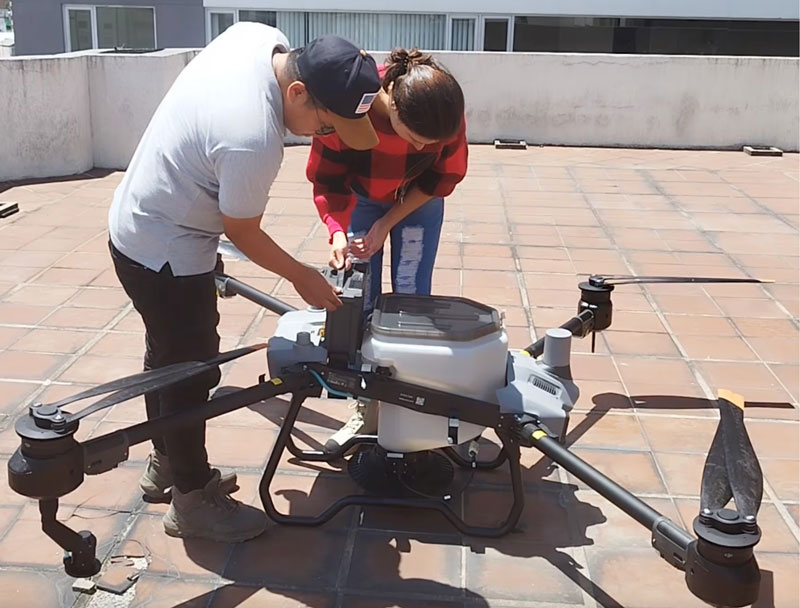This new technology can plant seeds 200 times faster than traditional methods.
The deployment of an innovative drone designed to swiftly plant 1,500 trees within a mere 15-minute window marks a transformative initiative in Ecuador’s reforestation endeavors, spearheaded by the Pontifical Catholic University of Ecuador. This groundbreaking project addresses the pressing environmental challenge of deforestation, a global menace exacerbated by various factors such as logging, forest fires, agricultural expansion, and the burgeoning demand for land for livestock grazing.
Julio César Benítez, the driving force behind the One Million Trees project at the Pontifical Catholic University of Ecuador, underscores the urgency of combating deforestation, which outpaces manual reforestation efforts. Traditionally, a mere 15 to 30 plants could be planted by hand in an hour. In stark contrast, the acquisition of a cutting-edge drone by the university enables the swift deployment of 1,500 seeds onto the ground in a quarter of an hour.
These technological strides aim to bridge the gap between the rampant pace of deforestation and reforestation efforts. Benítez highlights the advent of machines capable of felling, stripping, and loading trees within minutes, suggesting that technological advancements could match the pace of deforestation. He emphasizes that while drones complement traditional seedling methodologies, they significantly enhance efficiency, underscoring the evolving landscape of reforestation techniques.
The forestry drone boasts the capacity to transport up to 50 kilograms of pre-germinated seeds, targeting areas rendered inaccessible by geographical constraints or ravaged by forest fires. Statistical evidence indicates that drone-based reforestation is 80% more effective in rehabilitating fire-affected regions compared to conventional methods.
Ecuador’s recent forest fire statistics underscore the urgency of such innovative approaches, with 122 fires recorded in January 2024, resulting in the loss of 2,512.03 hectares of vegetation cover. Particularly affected provinces include Carchi, Pichincha, and Chimborazo, with Carchi experiencing the most devastating impact, losing nearly triple the vegetation cover of Pichincha.
Long-term benefits far outweigh the cost
Before initiating drone-based reforestation, meticulous species selection and trajectory calculations are conducted using artificial intelligence. Furthermore, the drone is equipped with a seed watering mechanism, optimizing seed viability. Although limited by a 20-minute flight duration, the drone’s operational efficiency is optimized through swift battery replacement, ensuring uninterrupted reforestation efforts.
A secondary monitoring drone equipped with cameras facilitates post-planting surveillance, crucial for assessing seedling survival rates. Benítez emphasizes the significance of monitoring, citing a mere 5% survival rate for planted seedlings due to the absence of stringent monitoring protocols.
The adoption of this pioneering technology remains in trial mode in 2024, aimed at garnering insights into diverse ecosystems across Ecuador, including the coastal dry forest devastated by agricultural encroachment. Preliminary research and seed preparation spanning seven months preceded the procurement of the drones, with the dispersal drone costing $25,000 and the monitoring drone priced at $15,000.
Despite the initial investment, long-term benefits are projected to outweigh costs, as the technology minimizes expenses associated with traditional reforestation methods, including tools, labor, and transportation. Benítez anticipates significant returns in the medium term, envisioning nationwide reforestation efforts propelled by increased seed dispersal.
Since its inception, the One Million Trees project has successfully planted 700,000 trees, with ambitious plans to achieve its target utilizing cutting-edge drone technology. This transformative endeavor epitomizes the intersection of innovation and environmental stewardship, offering a beacon of hope in the fight against deforestation.


A visual tool that tracks forest loss/gain yearly for 20 years. https://www.globalforestwatch.org/dashboards/country/ECU/
World Resources Institute is one of numerous groups hard at work with climate solutions. Thanks for running human ingenuity solving problems when informing the public tends to dwell on “who’s gonna win.” When covered, I see a focus on climate problems, with a bare smidgen about solutions.
I hope the is more native trees like Guayacán that are disappearing rapidly. Monoculture is disastrpus on the US and adds to the destructibe power of forest fires